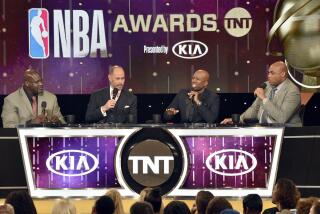Advertisers Wary of Pricey TV Deals for âER,â NFL
Advertisers are warning the networks, which this week signed eye-popping contracts to broadcast âERâ and National Football League games, to expect a fight over hefty rate increases.
Next seasonâs ad rates during league games and the top-rated drama could increase by as much as 20%, as television networks attempt to boost ad revenue to pay for the contracts. But media buyers said advertisers are unlikely to accept increases of more than 10% to 15%.
âI donât think theyâll come out with immediate outrageous increases, because if they do, theyâll drive those dollars away to other properties very fast,â said Peter Chrisanthopoulos, president for broadcast and programming at Oglivy & Mather Worldwide in New York. âItâs a supply-and-demand marketplace. The networks will price it where they think they can sell it, and weâll buy it where it makes sense.â
Under the deals signed this week, Fox, ESPN, ABC and CBS agreed to pay the NFL a staggering $17.6 billion to broadcast games over an eight-year period. Meanwhile, NBC signed an $850-million contract with Warner Bros. to keep âERâ for the next three years, bringing the cost per episode to as much as $13 million.
Professional football is attractive to advertisers because the games reach male viewers between ages 18 and 49, an elusive audience.
The importance of âERâ is less clear. Despite a strong buzz and continued high ratings, the dramaâs heavy female audience is easier to target.
âYou can find ERâs primary demographic, which is women between 18 to 49, anywhere on the TV dial,â said William F. Gloede, editor of trade publication Mediaweek. âYou can use other shows, magazines. I think NBC is going to try to increase rates, but theyâll meet resistance.â
Even football doesnât necessarily have a lock on advertisers. Some believe exorbitant rate increases could drive some away, especially with the continued fragmentation of the television audience to cable stations.
âWhile football is still valuable, itâs not the end-all to reaching young males,â said Bob Igiel, executive vice president and director of broadcast TV at Young & Rubicamâs Media Edge. âFor instance, automobile makers used to see football as a must-buy. Today, 60% of car-purchase decisions are influenced by females.â
Advertisers could try targeting young male viewers by airing a slew of commercials during âThe X-Filesâ and on the Discovery Channel and late-night talk shows. But they generally prefer hitting that group all at once.
âIt you want to cobble together that audience, you have to buy half a dozen prime-time spots, something on the Discovery Channel and maybe one of those war shows on the History Channel,â Gloede said.
This season, a 30-second commercial during Monday night football costs about $350,000, while a spot during a fall episode of âERâ might run $550,000, said Joe Mandese, editor of the Myers Report, which analyzes media spending among other industry issues.
Mandese believes networks will have a hard time justifying a rate increase of more than 20% for those programs, unless they offer advertisers more than what theyâre already getting.
âThe networks need to maintain profitability, but they have to convince advertisers that thereâs a value,â he said.
With increasing concerns about ad rates, there is some talk that the 20-second commercial might gain a more prominent prime-time presence as the standard 30-second spot becomes more cost-prohibitive.
But advertisers say more research needs to be done to determine whether they can convey effective messages in a shorter spot.
Another change is the earlier starting time for Monday Night Football. Though games will begin an hour earlier, moving to 5 p.m. on the West Coast, advertisers donât believe that the earlier kickoff will have a significant impact on advertising.
The say that the change could benefit national advertisers, because additional viewers in the East will more than compensate for lost viewers in the West. Local advertising rates in the West could be affected, media buyers said, but probably not significantly.
More to Read
The biggest entertainment stories
Get our big stories about Hollywood, film, television, music, arts, culture and more right in your inbox as soon as they publish.
You may occasionally receive promotional content from the Los Angeles Times.










